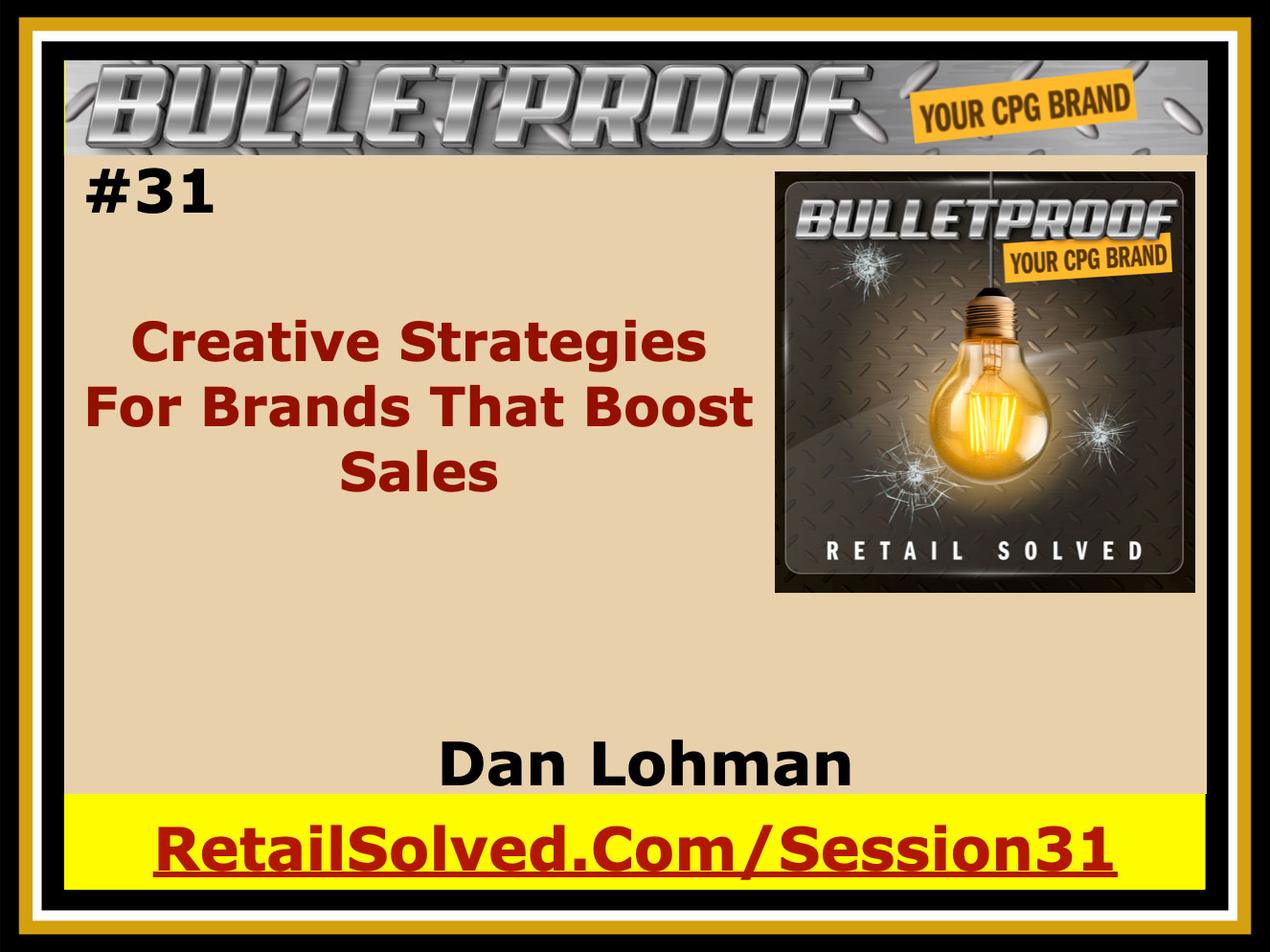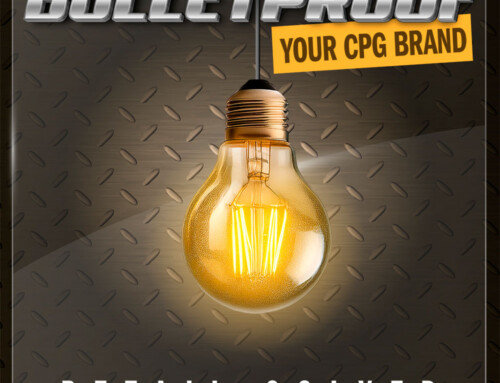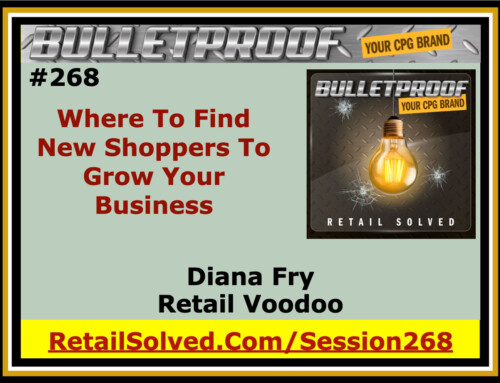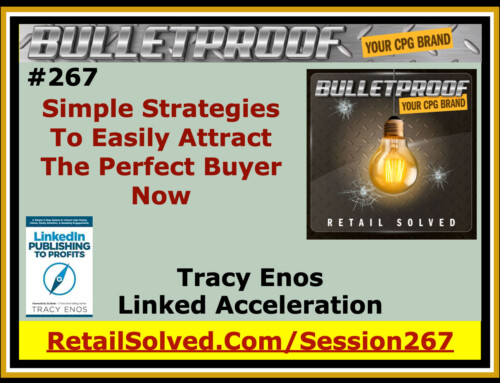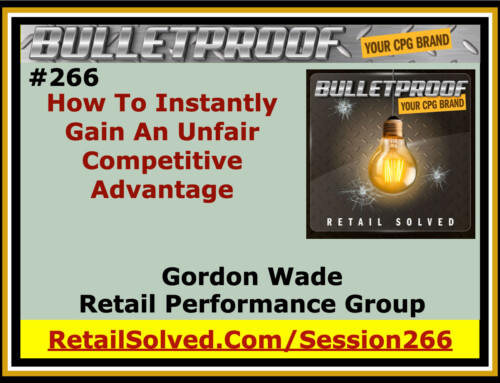xplore creative strategies for brands that drive sales and meet the needs of health-conscious consumers in a changing retail landscape. We discuss the importance of organic and natural products in driving sustainable growth and profit across all categories. We highlights the confusion among consumers about these products and provides retailers and brands with a solution to fix this.
The CMA (Category Management Association) asked me to produce a four part webinar series to highlight the differences between the mainstream shopper and the natural organic shopper. This podcast is the live recording of the webinar. I thought you might enjoy learning more about how retailers can drive sales leveraging these insights. I am including a link to the show notes and on this episode’s webpage on my website at the link below.
The retail landscape is changing. Brands and retailers need to partner together to better meet the needs of connected consumers through personalization, unified brand messaging that extends beyond the package, and focusing on natural organic growth trends
Listen where you get your podcast
Important: Brand Secrets and Strategies has been rebranded to Retail Solved. Please swap all BrandSecretsandStrategies.com URL’s with RetailSolved.com. This is now the Bulletproof Your Brand podcast. Thank you for listening! BRAND SECRETS AND STRATEGIES PODCAST #31 Hello and thank you for joining us today. This is the Brand Secrets and Strategies Podcast #31 Welcome to the Brand Secrets and Strategies podcast where the focus is on empowering brands and raising the bar. I’m your host Dan Lohman. This weekly show is dedicated to getting your brand on the shelf and keeping it there. Get ready to learn actionable insights and strategic solutions to grow your brand and save you valuable time and money. LETS ROLL UP OUR SLEEVES AND GET STARTED! Hello and welcome to Creative Strategies for brands that drives us at retail leveraging the growth of natural and organic products. My good friend Bill Bishop and I gave this webinar the Category Management Association on March 15, 2018. This is the second in a four-part series. There was, however, technical glitch and so the original recording doesn't exist. I'm going to try to rerecord it on my own and unfortunately do the time commitments they won't be able to do this with me. Here I go. By the way the webinar … the deck can be downloaded at categorymanagementretailsolved.com/cma2. Again that's categorymanagementretailsolved.com/cma2. Let me go back into our previous webinar defining the differences in your organic arena and who the shopper is. Shoppers are confused. They want to know which is healthier. The challenge here is that if the consumers are confused about what's better, then how does the retailer help them? Let's go through some of the key terms. One, natural. Natural is a term that we used to define the natural channel where you find it better for you healthy options, but the term natural as a product attribute really means nothing. Non-GMO. Non-GMO simply means that the seed, the actual seed if you will that is used to plant their product, the ingredient is non-genetically modified. Now, a non-genetically modified seed can be planted and cultivated in a field that is sprayed with pesticides and herbicides. Organic is automatically non-GMO, but the ground is as nature made it, in other worlds no pesticides or herbicides. Clean Label is a newer term that you're going to be hearing a lot. In clean label is a term that a lot of people use, a lot of companies use to define if you will the best of organic. Meaning simple to easy, to understand our ingredients that are organic. Which is best and why? Well, what is best is going to be organic or clean label. Again, the reason that this is important is because consumers want healthy products that they can trust. They want to know where the product comes from. They want to know how the product was produced, how it was grown, how it was cultivated, everything else. The basis, the foundation for this growth that you're seeing and across all categories and all channels it comes from this organic shopper that is looking for these authentic transparency. I mentioned the consumers are confused about organic. Consumers are curious as to, you know they don't if it means non-natural, chemical-free, non-GMO, et cetera. On this slide and again please download the deck so you can follow with me. On this slide, it lists several of the attributes that consumers are considering when they think about organic, but they'd really don't understand. Organic is, again, as it came from nature, non-genetically modified, no herbicides, no pesticides. By the way, USDA organic has to be certified on a regular basis. That is where that authority or that trust comes from. Let me help make some sense to this. A couple of years ago, I had the privilege of doing a feature article for the 2016 Category Management Handbook and I will include that on the same website. What I found in just looking at a data, data that I used in courtesy of Nielsen was that total food sales are up 1.9%. Natural and organic sales are up 11%. Natural and organic sales represent only 7.7% of total U.S. food sales. Total U.S. food sales in the absence of natural organic are only up 1.2%. Let me drive this home. This is where it's really search to making sense. Total U.S. dairy sales are up 1.5%. Total U.S. natural organic dairy sales are up 12.1%. That small sliver of natural organic sales represents only 9.8% of total sales. This is all outlet multi-billion dollar category. Total dairy sales in the absence of natural organic only up 0.5%. The point here is that natural organic sales are responsible for the sustainable growth and profit across all categories. Now, you noticed that the data on this is a little bit old. This is the first and I believe the only study that's ever done where we're really trying to understand what is the impact of natural organic on a category. Now, I can tell you from a lot of the projects that I've worked with with some of the most disruptive brands out there when I look at other attributes a gluten-free, non-GMO, et cetera, I'm seeing similar trends. Again, this is that core customer, that core customer is driving sales across every category. This is a customer that needs to be nurtured and supported not only by the brands but by the retailers. What is the core natural shopper look like and why does it matter? First of all, they're not clones. Have you ever gotten something, a great deal on something that you didn't like? We hear a lot of people say price, price, price. It's the only driver that gets consumers to buy. That's not true. If it was true then decadent products and luxury items would not be increasing in sale, would not be growing categories. The reality is that consumers want what they want. The committed natural shoppers will not settle. They want what they want. They want quality products. They want products that they could know, like, and trust. They want to understand not only where the product came from but how is it going to help them or benefit them nutritionally. The core natural shopper reads the labels. They understand probably far better than anyone in the store how that product is going to support their needs and their family's need from a natural standpoint. Mainstream retails where you're finding most of the growth in natural sales. Several years ago most of the sales came from the natural channel, independence, et cetera. Now you're seeing a lot of the mainstream retailers and drug, mask, food, et cetera, all selling natural products. The reason this is important is because we're seeing a shift, it's not a shift away from the independence, but we're seeing a lot of the larger brands, lot of a larger retailers moving toward mainstream, and the reason this is important is because mainstream brands and mainstream retailers understand the value of this unique consumer that's willing to pay a premium for the products that meet their needs. Now for today's webinar, creative strategies for brands that drive sales at retail leveraging the growth of natural and organic products. Health conscious consumers are looking for retailers to provide good selections of products that meet their needs across all categories. Focusing on their needs to drive sustainable category growth is the future of retail. Attitudes are driving changes. Consumers are looking for solutions that help with healthy aging. Consumers are moving from products that help if you will from a cure and help with more of a preventive of stands. Consumers are using food, organic healthy food to replace prescription medicine and excessive doctor visits. The fountain of youth is important. Consumers are looking for the fountain of youth and healthy products. They want to feel healthy and vital. The fountain of youth is what I'm talking about here is that when you feel healthy and vital, vibrant then that comes from within and that vibrancy from within extends outward. Natural organic products offer you the promise of nutrition focusing on "you are what you eat" and again if you are what you eat then what you eat matters. Let me explain. If you are what you eat, then if you eat something that doesn't fully meet your nutritional needs, then that product is not going to sustain or satiate you longer. I'm going to give you a couple of examples. One, if you go to the bread section for example and you're looking at the top of the … or say first of all you buy the cheap generic bread and say you're hungry within a couple of minutes and then you make a sandwich using the best mainstream bread out there and it's seven grains or whatever and that bread keeps you satiate for three or four hours, et cetera, then you look at the organic bread which might be 30 cents or 50 cents higher. That organic bread, because it better meets your nutritional needs, might say satiate you longer. Even though the organic bread might be more expensive on the shelf at the time of purchase, it's cheaper in the long run because it actually reduces your hunger and satiates you longer. Another example, if you're looking at for example milk, cows are not designed to eat hay and grain and things additives and stuff like that. Cows are designed to eat grass. If you drink milk that is from grass-fed cattle, then that grass-fed cattle produces more different nutrients and that grass-fed milk, satiates you longer. Consumers are very active. You hear the myth that consumers slow down as they age. That's not true. They change their activities. They might participate in intensive activities when they're younger but they move to less intensive activities as they grow older. Now, as you can see on the chart that consumers tend to walk or hike in terms of a form of exercise as they age. Exercise habits change as we age. Good nutrition pays an important role in these habits. By the way, these insights were provided courtesy of Euromonitor International who just got a tremendous amount of resources and they've been really fantastic in terms of helping me out with these presentations. Transparency matters. We're talking a little bit about that. Consumers just don't want to know what's written on the box in terms of the ingredients and the label. They want to know where the product comes from, how it was produced, where it was produced, et cetera. Again, going back to the grass-fed milk, they want to know that the cattle that is producing their food is all grass-fed, that the milk is organic. This is the kind of trust, the level of trust and authenticity that consumers are looking for. Consumers are shopping for health and wellness products, free from and organic are that leading areas where consumers are placing their trust. They want products that they can trust that are free from and organic. In this slide 46% of consumers are looking for free from and almost the same for organic. The share of organic products, the share of total sales continues to grow exponentially in food and it grows slightly in nonfood. The point is this, these are trends that are going to continue. Healthy shoppers are the future growth driver in CPG. Similar to the slide I showed you a minute ago, the point here is that these trends are going to continue and are forecasted to continue growing through at least through 2021. Health focus solution should continue to accelerate globally. Shoppers want vitality. It kind of goes back to what keep talking about. Shoppers want to be vital, have that vitality and that vibrance, that inner vibrance. The attributes that are feeding it or supporting that are products that boost endurance, energy boosting and free from and these categories this is where the majority of the growth is. Shoppers are very actively searching out products that promote health and vitality, products that enhance the quality of life. Another key consideration is shoppers want to live more active lives as they feel better. Those same shoppers are looking at these trends. Those trends are expected to continue to grow well beyond 2021. Shoppers are proactively looking for healthier more active lifestyles. These trends are the needs to reduce reactive solutions and including high blood pressure, obesity, diabetes, et cetera. Consumers are living longer and they want to feel better. They want to enjoy life. Belief drives choices. Younger consumers believe that they can make a difference through the choices and actions they make and that they'd rather spend their money on experiences rather than things. The point here is that younger shoppers are taking a lead when it comes to purchase driven and by values and beliefs. Organic products frequently support important causes that resonate with consumers. Shoppers choose retailers that align with their core values. Shoppers want to feel good the purchase decisions. The shopping experience is important. Shoppers, let me back up. I was at expo it was a week or so ago and I heard someone say that millennials believe that online is going to be the future, that traditional brick and mortar is going to be dead. This slide contradicts that and by the way I don't agree with that either. The point here is that shoppers will only try things before they buy it. Shoppers want to buy things and take it home immediately. Shoppers want choices. Traditional retail continues to be important to shoppers. The experience matters. When you go into a retail store, it's not just that you need to fill the items in your list. You go there for community. You go there for the theater, for the experience, learning about new products, maybe learning about what's new and what trends are in different categories. Forty seven percent of globally connected consumers want to try something before they buy it. Eighty three percent of consumers expect to make a purchase in store. At the heart of this is personalization. This works within … you see this trend in every single group. The point is that consumers want to feel relevant. They want to know that the retailers and their brands that they're buying are listening to them specifically, listening to their needs carefully. They want to know that they're providing solutions to best meet their needs. Shoppers are more connected. Almost every consumer has a smartphone today. Consumers are using technology to purchase decisions at retail. What we're talking about here is that when a consumer walks down a store, they don't just pick up the label and read it and read what the label says. They're using their phone to get into the internet, to do research on the product, define recipe options, to learn more about the product, who likes it, what the reviews were, et cetera? Brand messaging needs to extend beyond the four corners of the package. By the way on that note, I had the privilege of having a conversation with Bill on my podcast Brand Secrets and Strategies. It was Episode 6. Take a listen to it. We had a tremendous and fantastic conversation about this very topic, about how retailers and brands need to work together to help brands communicate or message beyond the four corners of their package. Consumers want solutions that make shopping easy and convenient. That ties back into this. Consumers want to be able to find products quickly. They want solutions in terms of the entire meal. They don't want to just focus on buying one box, one can of soup, one box of mac and cheese, et cetera. Retailers need to think about the entire solution, the entire buying solution. Smartphones make shopping easier. The shopper journey is changing. Consumer users shop the smartphones to make purchases. Contraband may continue to be a huge issue for a lot of companies that are selling online. One of the things that frustrates me a lot is when I go online to look at our product, I can't see the price until I put the product in my market basket, into shopping basket and then I decide at that point whether I wanted or not. I wish retailers would take it more proactive role of not trying to hide things for me, but put all that information upfront. The other key point is that selling extends well beyond the register. It includes input from family, friends and influencers. The point here is that selling starts the minute you put the product into the packaging and doesn't end until well after the consumer takes it home. It also includes when the consumer is sharing that food or whatever that is with their family and friends when the evangelist evangelizes it through social media and so on. Subscription services offer convenience. Consumers especially younger consumers are looking at subscription services because they understand value and appreciate how those subscription services make shopping easier for things at a routine purchase is stable if you will that doesn't mean that the brick and mortar store is in jeopardy of going away. What it means is that it augments your shopping. One of the terms that Bill's coined a couple of years ago which I absolutely love is that shoppers have what he calls a personal supply chain. The point is this, if shoppers don't find what they like in your store, they simply go elsewhere. The key here is that retailers need to be cognizant. Retailers need to do everything in their power to keep that shopper within their ecosystem, within their store to buy as many of the products that are on their shopping list. That's the way this game is played. Balancing privacy with conveniences continues to be a challenge. Most consumers agreed that they would be lost without their internet. Again, going back to the fact that consumers like to be able to research products online right there at store, right there on the shelf. In addition to that consumers put together their list. Before they go into the store, this is where a lot of the consumers do a lot of the research and then of course they listen to the shopping shows, et cetera, and they're trying to find which of the products best meet their needs. Remember, the core natural shopper is looking at how their product fits or meets their nutritional needs at a very granular level. Now, these are the slides that Bill added and unfortunately he's not here to be able to share his insights but some of the things that he said for example on this slide talking about health and wellness at retail. Bill was talking about a study that was done many years go and I'm sorry I don't have the name of the group that did it but he was talking about how relevant is that these trends have always been existent but the fact that these trends are now more a bigger factor now that brands and retailers need to pay more attention to it, if the small natural organic brands that are disrupting the way consumers by the way consumers think, the reason this is important is because the small natural brands are more closely connected to their core consumer. When you think about innovation, innovation comes from brands creating disruptive items. In mainstream, some of the brands they just slap a different label on it or something and call it a new item or maybe a different flavor and natural that customer is more aligned with the brand so the innovation that they're getting comes from directly, the brands working harder to create solutions that that particular customer wants. I've always said that natural is the R&D of CBG. Bill then talked about our personalization and preferences are important in what we chose underlying the mass market. The point here is that he was talking about drawing on the wisdom of the crowd. More and more consumers are focused on solutions that meet their needs. They want products that address their specific wants and needs and the retailers and the brands that can support that and help them if you find the products that they want. Those are the products that are going to continue to grow in the future. Connecting the dots between food and health. Again Bill is not here to chime in and share his thoughts about this but I will tell you that some of the comments that he made on this slide go back to the podcast, Episode 6 Brand Secrets and Strategies. The next slide he talked about habit. Their solution is food personalized. He was talking about an application and he's got it on the slide. He was talking about a company that can actually personalize your food selections. The personalized eating is here. Then Bill talked about how there's a company that provides genetic testing that actually helps you personalize you're eating and shopping habits. This next slide Bill talked about and this I thought was really fascinating. Raley's has what he calls a Shelf Guide: Your Custom Wellness Tool. Feud attributes bring together products under common themes. What he was talking about is he was walking to one of the stores that Raley's and they have a new format and what they're doing is they have under shelf tags they have two of the top eight of the different attributes that are most important to consumers to help make the buying decision easier. Hy-Vee and Shop-Rite, a couple of the retailers, King Soopers does it, Kroger, a lot of the different retailers are deploying in-house nutritionist and the point here is that retailers are doing their best to help support and help understand, help educate the consumers into how to best support their nutritional needs. Now the reason that this is important is because natural organic products should know their consumers far better than anyone else and natural organic products need brands, need to work closely with their retail partners to help educate the retail partners on how to best drive traffic to their categories. Personalization and the offering. One, the cornerstone of relevance. Consumers want to be relevant. Two, the basis for market segmentation. Consumers want selections or solutions that best fit their needs based upon how they look at the category, how they look at the market. Three, step towards to personalized supply chain. Now it gets back to what I was talking about that Bill said before where consumers want solutions that meet their needs. Again if a consumer can't find what they want in a store they'll simply go elsewhere. The opportunities for retailers and brands to work together to keep the consumer within that supply chain and at that retailer. How suppliers can shift until health suppliers can leverage this. One, become a part of the natural organic attribute. The point here was that retailers and brands need to focus on these natural organic attributes and how they're driving sales across to every store. They need to understand not only does what does their product bring in terms of food traffic but what are the other items that are in the basket when a consumer checks out. Two, understand what makes you unique. Consumers want personalized solutions, retailers or brands need to work together to understand what makes the consumer unique and how to meet their needs, again, tapping into perhaps their nutritional needs. For example, a gluten-free consumer needs products that meet their dietary needs as far as gluten-free. They need to not have to be forced to go on scavenger hunt when they go to retail. Three, create product content. We talked about this before earlier and again this is what the focus of that podcast is about. Consumers want to be able to look beyond the four corners of the package. They want to be able to understand not only what's written on the package but also what's not written on the package, where the product came from, how it was produced, when it's produced, all that other information. They want to in some cases be able to see which farmer produced the beef or milk the cow or raise the chicken, et cetera. It's this type of content that is really helping consumers make and guide them, make the choices that they wanted as they guide them through their shopping journey. Number four, partner with retailers. Retailers cannot be experts in every single item that they sell. It is the responsibility absolutely of brands to help step-up and it helps show that retails, help guide the retailers in everything about their product. Brands need to be an expert in their product, their competition, the category, the market, et cetera. Brands need to help drive that customer, help bring in that customer for that retailer through their marketing strategies, et cetera. The future of retail. The future of retail is changing. In this section here, Bill and I had a great interaction. I'm so sorry that we can't share this with you, but again if you listen back to the podcast we share a lot of those insights. As a side note, I just interviewed Phil Lempert, the Supermarket Guru. He and I had a very similar conversation. You're going to find that on my podcast brandsecretsandstrategies.com/session32 which will not be released for a couple of more days, but look for that. We have a similar conversation what Bill and I shared and that ties nicely into the conversation I had with Bill on brandsecretsandstrategies.com/session6. If you want to learn more about Brick meets Click and by the way highly recommend you subscribe to their newsletter and checkout some of the great downloads and the insights that they provide. Anyhow, you can visit brickmeetsclick.com or you can connect with Steve Bishop, the managing partner Brick meets Click. If you want to learn about more about me or about the natural organic shopper, listen to the Brand Secrets and Strategies podcast and checkout my free Turnkey Sales Stories Strategies Course. You can visit categorymanagementretailsolved.com for the links to both of this. In addition to that remember you can download this presentation at categorymanagementretailsolved.com/cma2. This episode's FREE downloadable Your brand's selling story is the cornerstone of all effective business building strategies. Learn How To Get Your Brand On The Shelf and What Retailers REALLY Want. This Is Your Roadmap To Success. CLICK HERE TO GAIN INSTANT ACCESS TO MY FREE TURNKEY SALES STORY STRATEGIES COURSE The third part of the webinar series is going to be Natural Organic Sales Begin in Produce. That webinar is going to be held Thursday, April 12, 2012 at 10:00 a.m. Central Time. Thank you again for listening. I really appreciate it. Have a great day. Thanks again for joining us today. Make sure to stop over at brandsecretsandstrategies.com for the show notes along with more great brand building articles and resources. Please subscribe to the podcast, leave a review, and recommend it to your friends and colleagues. Sign up today on my website so you don’t miss out on actionable insights and strategic solutions to grow your brand and save you valuable time and money. I appreciate all the positive feedback. Keep your suggestions coming. Until next time, this is Dan Lohman with Brand Secrets and Strategies where the focus is on empowering brands and raising the bar.
Enter your name and email address below and I'll send you periodic brand building advice, tips and strategies.
Sign up to receive email updates
FREE Trade Promotion ROI Calculator:
Click Here To Maximize Sales And Profits
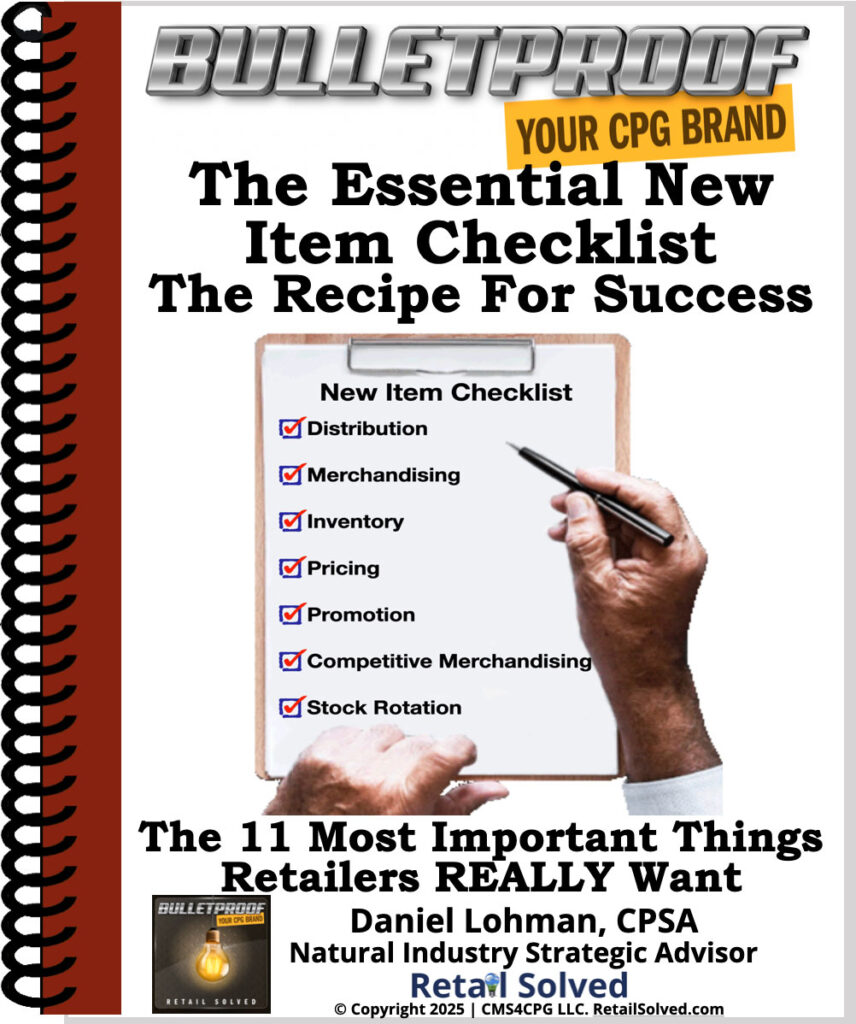
The Essential New Item Checklist – The Recipe For Success
Want A Competitive Edge? The Recipe For Success
New product innovation is the lifeblood of every brand. New products fuel sustainable growth, attract new shoppers and increase brand awareness. Learn the critical steps to get your product on more retailer’s shelves and into the hands of more shoppers. Maximizing your trade marketing can pour rocket fuel on your launch.
Image is the property of CMS4CPG LLC, distribution or reproduction is expressively prohibited.
